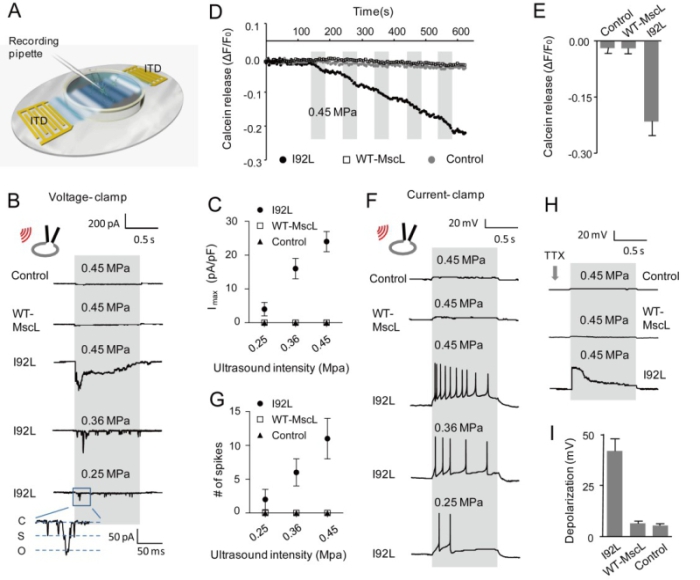Use Ultrasound to Open Mechano-Sensitive Ion Channel to Control Neuronal Activities
Date:02-07-2018 | 【Print】 【close】
Neurostimulation is among the fundamental ways of neuroscience to probe the neural mechanisms from molecular to behavioral levels. Ultrasound is a non-invasive neurostimulation tool has made possible for the effective amelioration of multiple functional brain diseases such as Parkinson disease, epilepsy and major depression.
Prof. ZHENG Hairong at the Shenzhen Institutes of Advanced Technology (SIAT) of the Chinese Academy of Sciences, in collaboration with Prof. LI Yuezhou, from Zhejiang University, reported a completely new method that uses ultrasound to open the Mechano-Sensitive Ion Channel (MscL) to control neuronal activities.
The team’s lab has fabricated various neuromodulation tools for different scales from single neuron to mice.
The neuromodulation chip consists of a pair of interdigital transducers (IDTs) patterned onto a piezoelectric substrate of 127.8° Y-rotated, X-propagating single-crystal lithium niobate (LN). Aluminum electrodes (200 nm thick) are deposited on a 1 mm thick LN substrate. And the chip is readily compatible with functional assays such as electrophysiological recording and calcium imaging, provide a powerful tool for investigating the mechanism of ultrasound neuro-modulation.
The neuromodulation systems for mice supports the synchronization input/output to facilitate neurophysiological devices such as Micro-Electrode Array(MEA) or patch clamp, which plays a key role in the key technologies study like non-invasive neuro-modulation and sonogenetics (Fig. 1).

Fig. 1 (a) Neuromodulation chip and (b) Neuromodulation system for mice. (Image by ZHENG Hairong)
In this study, they expressed MscL in rat hippocampal neurons in a primary culture and showed that it could be activated by low-pressure ultrasound pulses. The gain-of-function mutation, I92L, sensitized MscL’s sonic response, triggering action potentials at a peak negative pressure as low as 0.25 MPa. Further, the I92L MscL reliably elicited individual spikes by timed brief pulses, making excitation programmable. Because MscL opens to tension in the lipid bilayer, requiring no other proteins or ligands, it could be developed into a general noninvasive sonogenetic tool to manipulate the activities of neurons or other cells and potential nanodevices (Fig. 2).

Fig. 2 l92L mutant enables ultrasound-evoked neuron spiking.(Image by ZHENG Hairong)
This work has drawn wide interests. Robert Desimone, the director of the MIT McGovern Institute and the professor of Doris and Don Berkey, commented about this work: “…if one could use a noninvasive source of energy, such as ultrasound, to control neurons, this (a probe implanted in the brain to deliver the light) would have major research and clinical applications…and I am sure they will stimulate more research to test the use of ultrasound in many neural applications, both basic and clinical.”
The paper titled “Ultrasonic Control of Neural Activity through Activation of the Mechanosensitive Channel MscL” was published in Nano Letters on June 25, 2018.
